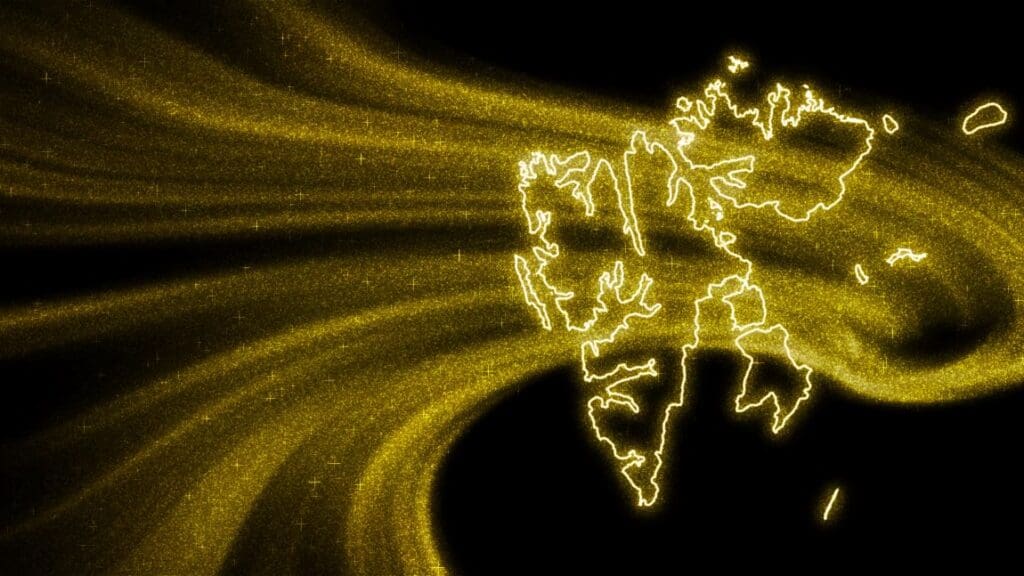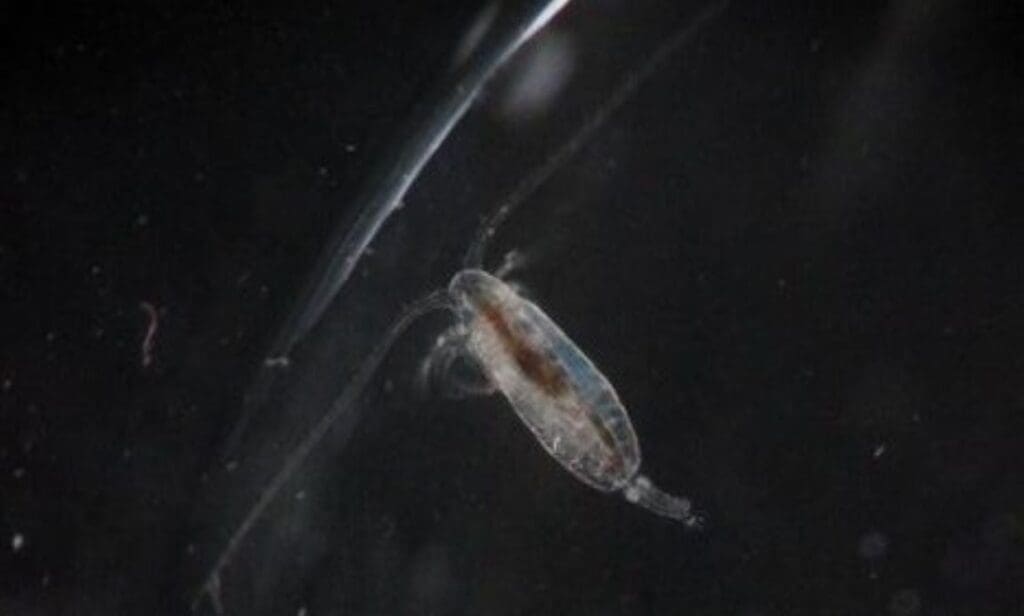Explore the latest insights from top science journals in the Muser Press daily roundup, featuring impactful research on climate change challenges.
In brief:
UCLA study: How to break through climate apathy
Slowing human-caused climate change requires decisive action, but the slow upward creep of global temperatures contributes to apathy among people who don’t experience regular climate-driven disasters, psychologists say. In a new study from UCLA and Princeton, researchers looked into ways to communicate the true impact of climate change and found a solution.
Showing people continuous data, such as temperature increases in a town, left people with a vague impression of gradual change, but showing binary data for the same town, specifically whether a lake froze or not each winter, brought home the striking shift, said incoming UCLA communications professor and cognitive psychologist Rachit Dubey.
“People are adjusting to worsening environmental conditions, like multiple fire seasons per year, disturbingly fast,” said Dubey, senior author of the study. “When we used the same temperature data for a location but presented it in a starker way, it broke through people’s climate apathy. Unfortunately, compared to those who looked at a clearer presentation of the same information, those who only looked at gradual data perceived a 12% smaller climate impact and cared less.”

Dubey studies how people reason about climate change, how to communicate about it and how to improve climate communications. He noted how heavily political and personal experiences influence risk perceptions around climate change, and how quickly people redefine “normal.” A Vox article reporting on climate apathy in 2020 inspired Dubey to look deeper into the human tendency to adjust to change, even as science has proven that humans’ greenhouse gas emissions are causing climate change and increasing disasters like wildfires, droughts, floods, hurricanes, and sea-level rise.
“For years, we assumed that if the climate worsened enough, people would act, but instead, we’re seeing the ‘boiling frog’ effect, where humans continuously reset their perception of ‘normal’ every few years,” Dubey said. “People are adjusting to worsening environmental conditions, like multiple fire seasons per year, disturbingly fast. My research examines how people are mentally adapting to the negative changes in our environment.”
In the study, published in the journal Nature Human Behavior, the researchers first asked study participants about the climate in a fictional city they named “Townsville,” and later asked a second group about five real lakeside cities around the world, including Lake George in New York and Grand Traverse Bay in Michigan. In both versions of the experiment, the scientists showed half of the study participants a graph of temperature increases from 1940-2020, and the other half a graph showing whether temperatures caused the lake to freeze each winter.
Whether charting temperatures or lake freezes, each pair of charts drew from the same slowly warming weather information. As temperatures gradually climbed, the lakes stopped freezing as often. For the real towns, study participants hearing about the lake also learned about the decline of activities like ice skating and ice fishing.
When the researchers asked participants to rate from 1 to 10 how much climate change impacted the town, people who learned about a range of temperatures responded lower than people who learned whether the lake froze — on average, 6.6, compared to 7.5, or 12% higher.
Making the emotional connection to local traditions, whether ice skating in the winter or freedom from wildfire smoke in the summer, may also contribute to overcoming apathy, said lead author Grace Liu, a Ph.D. student at Carnegie Mellon University.
“Our study drives home the importance of discussing climate change not just in gradual temperature terms, but in concrete, either-or terms, showing how life has changed,” Liu said. “It’s not just warmer winters; it’s also a loss of ice hockey and white Christmases. It’s not just hotter summers; it’s the disappearance of a swimming hole due to drought or soccer practice (being) canceled because it’s dangerously hot.”
The researchers hope the results help anyone designing visual representations of climate change graphics or those seeking to clarify gradual changes, from climate generalists and data visualization professionals to policymakers and journalists.
“People working in these fields have a sense that binary data is more effective, and our study adds theoretical rigor, using careful cognitive experiments,” Dubey said. “Our study also helps explain why the ‘Show Your Stripes’ visualization is so compelling because it takes continuous data and presents it in a more binary format.”
By focusing on the increasing rate of once-rare events, like extreme heat days or thousand-year floods, or the slow loss of seasonal joys like skiing or outdoor ice skating, the researchers hope that the same temperature data that once led to public apathy can instead help communities care more about the climate crisis.
Journal Reference:
Liu, G., Snell, J.C., Griffiths, T.L. et al., ‘Binary climate data visuals amplify perceived impact of climate change’, Nature Human Behaviour (2025). DOI: 10.1038/s41562-025-02183-9
Article Source:
Press Release/Material by University of California – Los Angeles (UCLA)
Finding ‘win-win-wins’ for climate, economics and justice
As evidence continues to pour in showing that climate change’s impacts disproportionately affect disadvantaged communities around the globe, so, too, do stories showing that these communities can also pay outsized costs to implement climate solutions.
Yet, in examining the available body of data and literature detailing how different countries have rolled out climate change mitigation strategies, research led by the University of Michigan has found reasons for optimism.
“It’s not all doom and gloom,” said report author Peter Reich, professor at the U-M School for Environment and Sustainability, or SEAS, and director of the Institute for Global Change Biology.
“I think there’s an expectation that poor countries have to pollute to bring a middle-class life to most of its people, like we did. But we’ve seen some low-middle-income countries start to decarbonize through investing in renewables and increasing energy efficiency. And they are lowering their emissions while reducing income inequality and increasing the well-being of their people.”
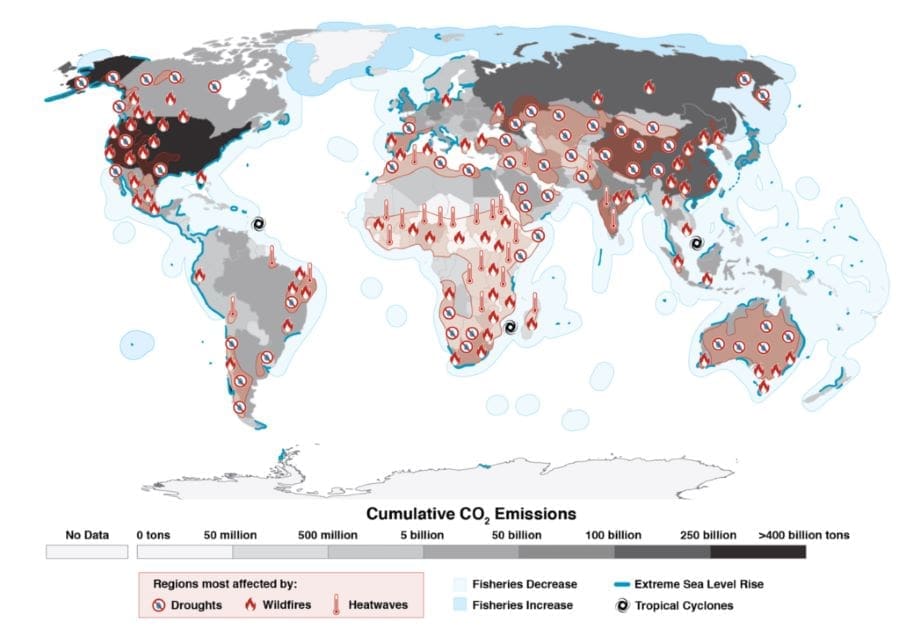
At the same time, Reich said, it’s all too easy to find cases where vulnerable peoples experience negative consequences from investments in renewables. Take, for example, Indigenous people who have been forced off of their land to build a hydroelectric dam. In fact, that was part of the inspiration for the new study.
There are hundreds of research articles and as many pages of Intergovernmental Panel on Climate Change (IPCC) reports that highlight such inequities. These are found both in the effects of climate change and also in the mitigation strategies used to slow and stop climate change. Reich and his collaborators wanted to extract broader insights by starting to bring those individual reports together under a systematic and comprehensive analytical framework.
In its new report, the team examined connections between climate impacts, mitigation strategies and social justice considerations, like wealth distribution and overall public health and well-being.
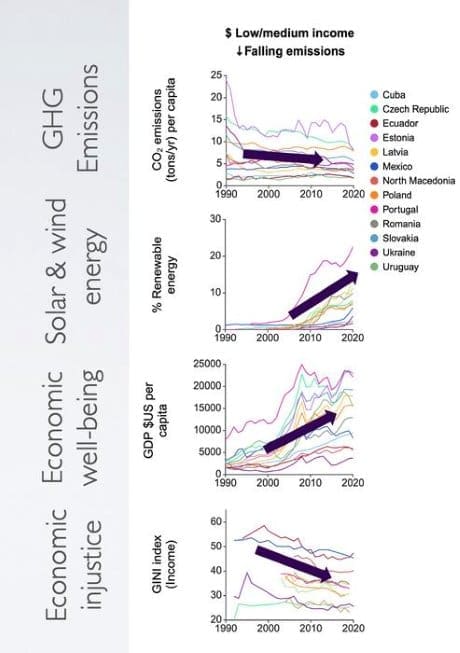
And, while the effort did show certain countries performing better and worse by certain metrics, the team’s goal wasn’t to rank, praise or critique. It was to find an answer to a much more fundamental question: Is there evidence that it’s possible to build up sustainable policies and infrastructure in a just way?
“Because inequity can result from mitigation actions themselves, sometimes that can have a perverse effect and actually slow down the broader adoption of mitigation strategies,” said Reich, who is also a professor at the University of Minnesota.
This slowing has contributed to a dogmatic belief that asking poorer countries to move to renewables is asking their people to suffer, he added.
“But there’s no consistent evidence suggesting that moving to renewable energy has overall negative impacts or consequences for poorer countries or their peoples,” Reich said. “If countries are able to invest in renewables, we’re seeing cases where it’s actually beneficial for their people, it’s reducing pollution and it’s slowing climate change. It’s a win-win-win.”
As an example, the team found thirteen low-to-medium-income countries that were increasing their renewable deployment along with their average income and gross domestic product per capita over the last 30 years. Those countries also saw their emissions and Gini indices, a measure of inequality, drop.
“We’re not saying it’s all causally related,” Reich said. “But there’s no evidence that renewables are getting in the way of equity or economic advancement.”
The team’s work was published in the journal Proceedings of the National Academy of Sciences.
Another important point that Reich stressed is that this does not let wealthy countries with high emissions, such as the U.S., off the hook. They still need to work harder to decarbonize in order to reach international climate goals, he said, but he believes the economic data will compel them to act.
“Every decade that we wait to take action, we see the cost of climate change damages go up astronomically and the cost of renewables go down,” Reich said. “That’s not just me, some ecologist, making up these numbers. They come from major corporations and insurers whose jobs are to understand the risks.”
Although he admits time could prove him wrong for feeling this way, Reich does walk away from the team’s study with optimism.
“We’re not wide-eyed idealists. The international community hasn’t solved this yet, and is not going to solve it tomorrow,” he said. “But we can slow and eventually stop climate change, and do so while actually saving money and enhancing environmental justice.”
The research team also included Kathryn Grace of the University of Minnesota, Harini Nagendra of Azim Premji University in India and Arun Agrawal of the University of Notre Dame. Agrawal is also an emeritus professor with SEAS.
Journal Reference:
P.B. Reich, K. Grace, A. Agrawal & H. Nagendra, ‘Mitigation justice’, Proceedings of the National Academy of Sciences 122 (17) e2411231122 (2025). DOI: 10.1073/pnas.2411231122
Article Source:
Press Release/Material by University of Michigan
Study of ‘spatial synchrony’ using long-term data exposes ecological trends and could boost conservation, farming
Populations of animals and plants separated by even thousands of miles can rise and fall together driven by ecological factors, a phenomenon scientists call “spatial synchrony.”
A new research from the University of Kansas and published in Ecology Letters reveals the study of spatial synchrony over a long enough timescale leads to better testing of ideas, improved statistical results and new conceptual realms for understanding ecology, conserving species and farming more profitably.
“There are many examples of this,” said lead author Daniel Reuman, professor of ecology & evolutionary biology at KU and senior scientist with the Kansas Biological Survey & Center for Ecological Research. “One study from the early 2000s examined two populations of musk ox on opposite sides of the Greenland Ice Sheet. Even though they were separated by 1,000 miles of ice, their populations fluctuated in sync — they had good years and bad years at the same time.”
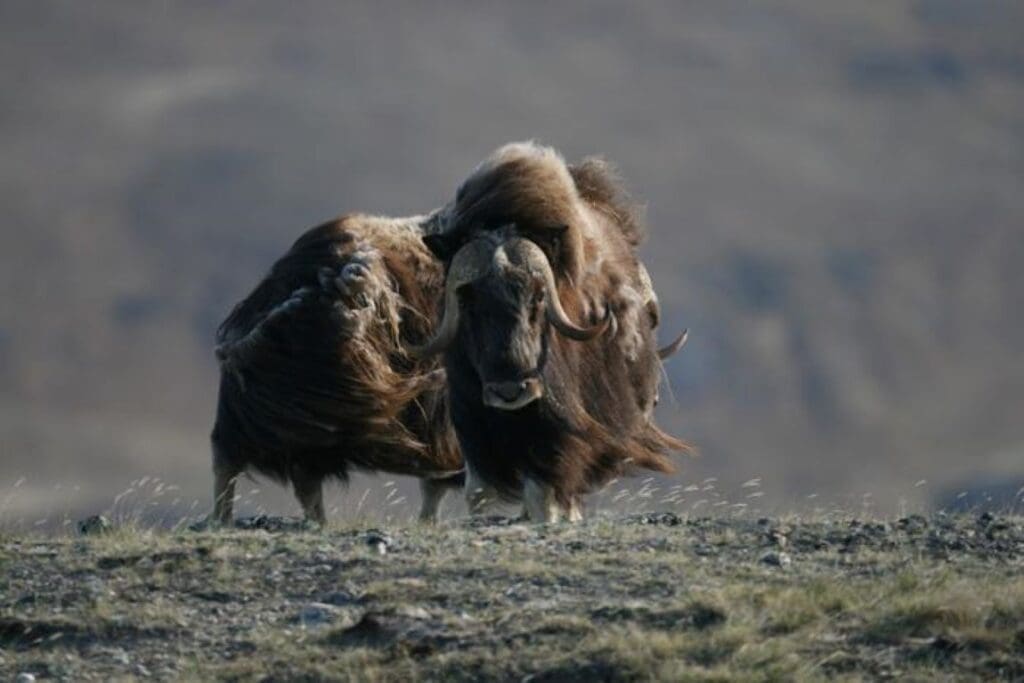
Reuman said his study reviews the most important conceptual developments in spatial synchrony over the past 20 years.
“One of these is timescale structure,” he said. “Populations don’t just fluctuate — they do so on multiple timescales simultaneously. They might change on an annual basis, as expected, but they also fluctuate on decadal scales and beyond. The causes of these fluctuations vary, and synchrony can differ depending on the timescale.”
Along these lines, Reuman and his co-authors found studies focused on longer-term timescales could be considerably more valuable to scientific understanding than those with shorter time considerations.
“If you have a study that lasts 20 years, it’s more than twice as valuable as a 10-year study,” he said. “The value increases exponentially. We wanted to highlight ways that long-term scientific monitoring efforts in our field have led to paradigm shifts in conceptual understanding. We feel really fortunate to study on the backs of some of these long-term monitoring projects, many of which have been ongoing for decades. We wanted to highlight what that does for scientific understanding and the importance of supporting those efforts moving forward.”
According to study co-author Max Castorani from the University of Virginia, the findings add a new element to value of long-term environmental research.
“Studies lasting several decades are rare in science but play an outsized role in generating knowledge,” Castorani said. “Our new synthesis further demonstrates that sustained investment in long-term ecological studies yields breakthroughs in understanding the natural world and its influence on society and industry. This leads to big gains in informing policy and management related to the environment, from climate and weather to forestry and fisheries.”
Lawrence Sheppard, a co-author from the Continuous Plankton Recorder Survey, said: “The advantage of having long-term data on plankton abundance is twofold: With the right techniques, you can get good statistics about repeating seasonal changes in the data and also uncover long-timescale changes in the oceans.”
Reuman said figuring out the environmental drivers of synchrony is another important line of inquiry in the new study.
“Years ago, researchers had decent theoretical ideas about what caused synchrony, but those ideas were largely untested in real populations,” he said. “In only a few cases could they definitively pinpoint a cause. Today, thanks to better tools and long-term datasets, scientists can make more accurate inferences about the factors driving synchrony — provided they have sufficient data. Because different causes can influence synchrony at different timescales, researchers must analyze data accordingly to identify the drivers effectively.”
The KU researcher said the drivers and effects of synchrony, along with how synchrony itself operates, can change over time. The theoretical frameworks described in the study have led to a more granular understanding of human-driven global warming as environmental changes are predicted to come faster in coming years.
“The third major trend we look at involves changes in synchrony,” Reuman said. “This ties to long-term monitoring efforts. If you need a certain amount of data to detect synchrony, you need even more to detect changes in it over time. These changes have increasingly been linked to climate oscillations, which in turn are connected to climate change. Scientists have studied the effects of climate change in many ways, but only recently have we recognized that changes in large-scale synchrony patterns can be another consequence of shifting climatic variables.”
Lastly, Reuman and his co-authors examine research trends into the mechanisms of synchrony — factors that influence synchrony in ways that might not be immediately obvious. These mechanisms are varied and require detailed study of long-term data to uncover.
Reuman’s co-authors were Vadim Karatayev and Nat Coombs from KU; Jonathan Walter, Ethan Kadiyala, Amanda Lohmann, Kyle Haynes and Max C.N. Castorani from the University of Virginia (with Walter also affiliated with the University of California-Davis); Lawrence Sheppard from the Marine Biological Association of the United Kingdom; Thomas Anderson from Southern Illinois University Edwardsville; and Lauren Hallett from the University of Oregon. Karatayev is also affiliated with the University of Maryland.
Reuman said the value of understanding spatial synchrony went beyond purely scientific inquiry. Work on synchrony could help farmers predict outbreaks of disease and pests or know when market prices might be apt to rise or fall based on climactic factors unseen without a grasp of synchrony.
“You can imagine this in an agricultural context,” he said. “In a study from 2016, we examined population synchrony in aphids, a major crop pest. When aphid populations synchronize across a region, it means pest outbreaks occur simultaneously in multiple areas, potentially reducing crop yields across the entire region.”
Beyond pests, synchrony can also affect crop yields themselves, Reuman said.
“For example, if all corn farms in Kansas experience a poor harvest in the same year, less corn will be available on the market, impacting prices,” he said. “However, if some farms have a bad year while others do well, they balance each other out. The first scenario represents synchronous fluctuation, while the second is asynchronous fluctuation. The same concept applies to disease outbreaks. Whether populations are synchronous or asynchronous can have significant consequences depending on the context.”
Journal Reference:
Reuman, D.C., Walter, J.A., Sheppard, L.W., Karatayev, V.A., Kadiyala, E.S., Lohmann, A.C., Anderson, T.L., Coombs, N.J., Haynes, K.J., Hallett, L.M. and Castorani, M.C.N., ‘Insights Into Spatial Synchrony Enabled by Long-Term Data’, Ecology Letters 28, 4: e70112 (2025). DOI: 10.1111/ele.70112
Article Source:
Press Release/Material by Brendan M. Lynch | University of Kansas
Trawling-induced sediment resuspension reduces CO₂ uptake
The resuspension of seafloor sediments – triggered by human activities such as bottom trawling as well as natural processes like storms and tides – can significantly increase the release of carbon dioxide (CO2) into the atmosphere. When these sediments are exposed to oxygen-rich seawater, large-scale oxidation of pyrite occurs. This reaction plays a much greater role in CO2 emissions than previously assumed, exceeding the contribution from the oxidation of organic carbon. The new study provides the first quantitative evidence of this effect in the western Baltic Sea.
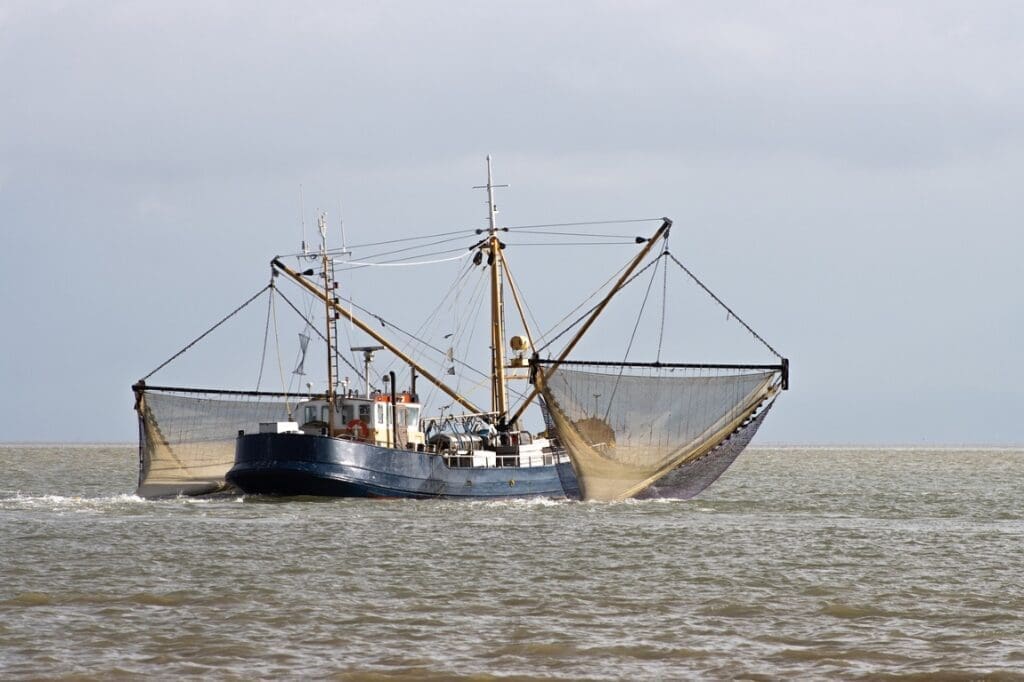
“Fine-grained, muddy sediments are important reservoirs of organic carbon and pyrite,” says lead author Habeeb Thanveer Kalapurakkal, a PhD student in the Benthic Biogeochemistry working group at GEOMAR. “We already knew that sediment resuspension can release significant amounts of CO2 into the water column. But until now, it was believed that this was mainly due to organic carbon oxidation.”
The new study, published in Communications Earth & Environment, now shows that the major part of the CO2 release is caused by pyrite oxidation.
Kiel Bight: A Critical Carbon Sink at Risk
The study focused on Kiel Bight, a coastal region in the western Baltic Sea located between the German island of Fehmarn and the Danish islands. This area features a range of sediment types: coarse sandy sediments in shallower waters and fine-grained mud in deeper regions. These muddy sediments are rich in organic matter and play a central role in the carbon cycle of the Baltic Sea. They are affected both by natural forces such as storms and by anthropogenic impacts like bottom trawling.
Laboratory Experiments Reveal New Insights
To study the effects of sediment resuspension, the researchers conducted sediment slurry incubations. They collected sediment samples from different sites in Kiel Bight — ranging from coarse sandy to fine grained muddy sediments — and stirred them in laboratory containers filled with seawater. The experiments simulated both oxygen-rich and oxygen-poor conditions.

During the incubation period, the team monitored changes in key chemical parameters, including CO2 concentrations, pH, sulfate, nutrients and isotope concentrations. These measurements allowed them to identify the underlying processes and assess their impact on the local carbon cycle. The laboratory data were then integrated into a biogeochemical model to better understand the effects of sediment resuspension and oxygen availability.
Pyrite Oxidation: A Key Factor in CO2 Release
The results show that sediment resuspension leads to substantially greater CO2emissions than previously thought — mainly due to the oxidation of pyrite. When this iron-containing mineral, typically found in oxygen-poor, muddy seafloor sediments, is disturbed it reacts with oxygen in the water. This reaction generates acid that converts climate-neutral bicarbonate into the greenhouse gas CO2.
A large fraction of the CO2 generated by pyrite oxidation is subsequently released into the atmosphere. Modeling results suggest that these processes could significantly reduce the region’s CO2 uptake capacity. In other words, resuspension can turn the seafloor temporarily from a carbon sink into a carbon source.
Protecting Sensitive Seafloor Areas to Preserve CO2 Uptake
“Kiel Bight, like other parts of the Baltic Sea, acts as an important sink for atmospheric CO2,” says Kalapurakkal. “Our experiments and model simulations show that activities such as bottom trawling significantly reduce this capacity by promoting pyrite oxidation and acidification.”
The findings underscore the need to protect seafloor areas with fine-grained, muddy sediments — regions typically rich in pyrite. Kalapurakkal: “These areas need to be protected to maintain the CO2 uptake capacity of the Baltic Sea.”
Journal Reference:
Kalapurakkal, H.T., Dale, A.W., Schmidt, M. et al., ‘Sediment resuspension in muddy sediments enhances pyrite oxidation and carbon dioxide emissions in Kiel Bight’, Communications Earth & Environment 6, 156 (2025). DOI: 10.1038/s43247-025-02132-4
Article Source:
Press Release/Material by Helmholtz Centre for Ocean Research Kiel (GEOMAR)
Hotter temps trigger wetlands to emit more methane as microbes struggle to keep up
Rising temperatures could tip the scale in an underground battle that has raged for millennia. In the soils of Earth’s wetlands, microbes are fighting to both produce and consume the powerful greenhouse gas methane. But if the Earth gets too hot, a key way wetlands clamp down on methane could be at risk, according to a Smithsonian study.

Methane is responsible for roughly 19% of global warming, according to the National Oceanographic and Atmospheric Administration. And while wetlands are champions at removing carbon dioxide (CO2) — the more abundant greenhouse gas — they are also the world’s largest natural source of methane. As nations set targets to bring down methane emitted from human activity, it is crucial to understand how much methane wetlands emit naturally — and how much more they could emit in the future.
“If there is a large amount of methane emissions from wetlands, and if we don’t know anything about that, then our carbon reduction target for mitigating climate change is going to be off track in the future,” said lead author Jaehyun Lee. Lee, who now works at the Korea Institute of Science and Technology, did the study while a postdoctoral fellow at the Smithsonian Environmental Research Center.
Microbial Tug-of-War
In wetland soils, two types of microbes are locked in competition. Some microbes produce methane, a greenhouse gas up to 45 times stronger than CO2. But other microbes consume that methane, using oxygen to turn it into less-harmful CO2. That simple transformation is one of nature’s most powerful ways to keep greenhouse gas emissions in check.
The new study, published in the journal Science Advances, focused on a special class of microbes known as anaerobic. Anaerobic microbes live in places without free oxygen — zones that are quite common in flooded wetlands. For a long time, they have been the underdogs in the methane wars. With no free oxygen to draw from, these microbes were believed to be unable to consume methane. When scientists finally discovered they could (by pulling oxygen from nearby sulfate molecules), they still thought it was a minor background effect compared to the microbes in oxygen-rich parts of the wetland.
“They thought that the anaerobic methane [consumption] process is going to be too slow to remove a significant amount of methane,” Lee said.
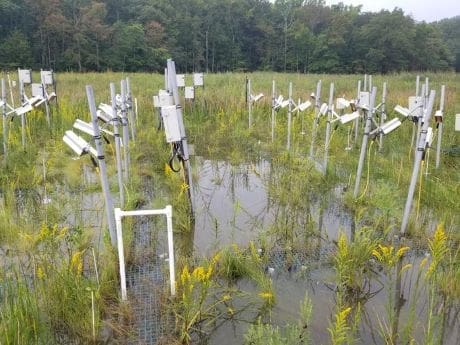
But as Lee pointed out, most methane production happens in these oxygen-starved environments. This essentially means anaerobic microbes are on the front lines. And they are pulling their weight. In the Smithsonian wetland Lee worked in, anaerobic microbes can remove up to 12% of the methane — far less than their oxygen-loving counterparts, but more than scientists previously suspected. And in saltier, sulfate-rich places, anaerobic microbes can remove up to 70% of the methane produced in oxygen-deprived soils.
However, things changed when scientists dialed up the heat.
A Fast-Forward Climate Experiment
In the new study, the team simulated a hotter future using an experiment on a wetland at the Smithsonian Environmental Research Center (SERC) in Maryland. The experiment goes by the name “SMARTX” (short for “Salt Marsh Accretion Response to Temperature eXperiment”). Scientists raised the temperature by 5.1 degrees Celsius in certain parts of the wetland by energizing rows of infrared lamps and underground cables. In some plots, the team also raised CO2 to create a more realistic future.
“You’re never going to get a warmer world without also having higher CO2 in the atmosphere… What SMARTX is doing is trying to mimic that warmer world, with the aboveground and belowground heating,” said Genevieve Noyce, a coauthor and senior scientist at SERC. “But because that’s not going to happen independent of CO2, we also cross it with CO2, so we have a real future that has both.”
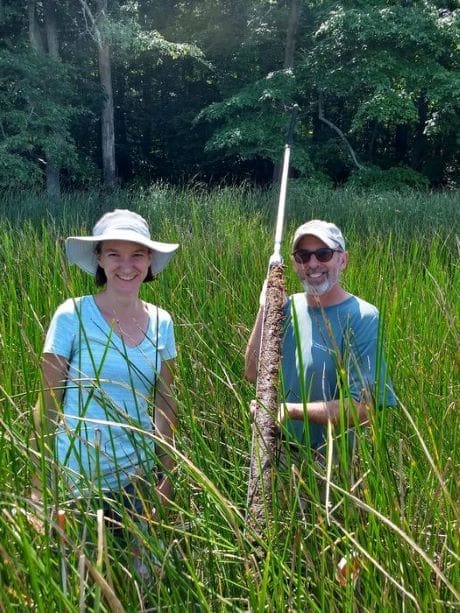
Methane emissions spiked under hotter temperatures alone. This was not because the helpful microbes became weaker. Warmer soils triggered them to remove even more methane than before. However, their competitors — the microbes that produce methane — became more active as well. And in a warmer world, the methane-removing microbes were unable to keep up.
How much methane emissions went up depended on the plants. In areas dominated by thick sedges, methane emissions rose nearly four times higher. But where smaller grasses prevailed, methane emissions increased only 1.5 times.
Ironically, higher CO2 lessened the impact — but not enough to cancel it out. Methane emissions in the sedge plots rose to just double normal levels, rather than nearly quadrupling, when scientists tested higher temperatures and higher CO2 together. The researchers suspect this is because CO2 triggers plants to grow bigger roots. Roots inject more oxygen into the soil, creating even more oxygen-rich sulfate compounds for the microbes to use.
“Warming is going to have a really big effect on increasing methane emissions,” Noyce said. “But when you add elevated CO2, it kind of brings it back down a little bit.”
This pattern holds for microbes across the entire wetland. In 2021, the team discovered that microbes in oxygen-rich soils behave the same way as the oxygen-starved microbes in this study. When the environment heats up, microbes that remove methane fall further behind their methane-producing cousins.
Conserving wetlands is still a vital part of protecting the world from climate change, the authors said. They are lifesaving buffers from hurricanes and extreme weather. And despite the methane issue, wetlands excel at locking away planet-warming carbon in other forms. An acre of coastal wetland can store more carbon than an acre of tropical rainforest.
“There is great value in protecting and restoring coastal wetlands to benefit climate, especially when we consider the many ecosystem services they provide to people,” said Pat Megonigal, the senior author and associate director of research at SERC.
But to plan for the future, policymakers need to know how much methane wetlands will emit in the decades to come. At the end of the day, Lee said, climate change is not only about hotter temperatures. It is also about the invisible activities that could tip the balance of greenhouse gases.
“We also have to consider, how is climate change going to affect these delicate microbial processes, such as methane oxidation and methane production?” he said.
Journal Reference:
Jaehyun Lee, Yerang Yang, Hojeong Kang, Genevieve L. Noyce, and J. Patrick Megonigal, ‘Climate-induced shifts in sulfate dynamics regulate anaerobic methane oxidation in a coastal wetland’, Science Advances 11, 17: eads6093 (2025). DOI: 10.1126/sciadv.ads6093
Article Source:
Press Release/Material by Smithsonian
Featured image credit: Gerd Altmann | Pixabay



